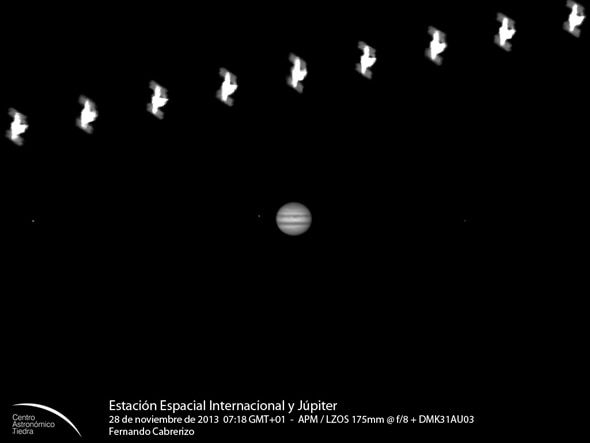Create a free profile to get unlimited access to exclusive videos, sweepstakes, and more!
The Space Station and the King of the Planets

I do love a good juxtaposition. In astronomy, we have lots of fun terms for the times when two objects get close to each other in the sky: conjunction, appulse, syzygy ⦠and if one passes directly in front of the other we get a transit or an eclipse.
The sky is big, so these events donât happen very often. The planets all orbit the Sun in more or less the same plane, so we do see them slide past each other in the sky fairly often, but satellites are a different matter. We tend to launch them at different angles, so their path in the sky doesnât often bring them close to some other bright, obvious object.
But it does happen, and if youâre prepared, you can get some pretty cool pictures and video of it. On the morning of Nov. 28, 2013, as seen from the Tiedra observatory in north central Spain, the International Space Station appeared to pass very close to Jupiter. Armed with some software to predict the time and geometry of the pass, astronomer Fernando Cabrerizo was able to capture video of the flyby:
That is so cool! I like how the individual frames show the shape of the ISS. Smeared, to be sureâitâs moving pretty dang rapidly across the sky, it gets fuzzed out due to atmospheric distortion as well, and itâs a bit overexposed compared to Jupiterâbut you can see it. And Jupiter looks lovely; its cloudy zones and belts striped across its face, and three moons, too: Ganymede (on the left), Europa (very near the planet on the left), and Io (on the right).
The geometry of this is interesting. Jupiter is very far away; it was about 660 million kilometers (410 million miles) distant at the time. The ISS is only about 370 kilometers (230 miles) off the Earthâs surface. This means two observers on different parts of the Earth will see the ISS in different places on the sky, while Jupiter will look pretty much the same to them. This is called parallax, and itâs like how close by trees will fly past you when you drive down a road, but a distant mountain hardly appears to move at all.
So the position on the Earth was critical for aligning the big planet and the station. If the observatory had been located just 1.2 kilometers (3/4 of a mile) northeast, they wouldâve seen a transit; the ISS would have passed directly in front of Jupiter! Iâm not complaining, though. Itâs still an amazing sight.
Sometimes when Iâm out with friends and neighbors looking at the sky, weâll see an airplane fly close to the Moon or some starâsometimes passing right in front of itâand weâll laugh in delight. Itâs silly, I know, but itâs still fun. There are so many airplanes and so many stars that itâs bound to happen fairly often. But something like what Cabrerizo captured is far more rare, and it makes me happy that we live in a time where we can make something like this happen (the ISS was built and launched on purpose, after all), but also predict it (the software they used to do this can be found here), capture it, and share it with the whole world.
Tip oâ the lens cap to Manu Arregi Biziola for sending me the link to this.














